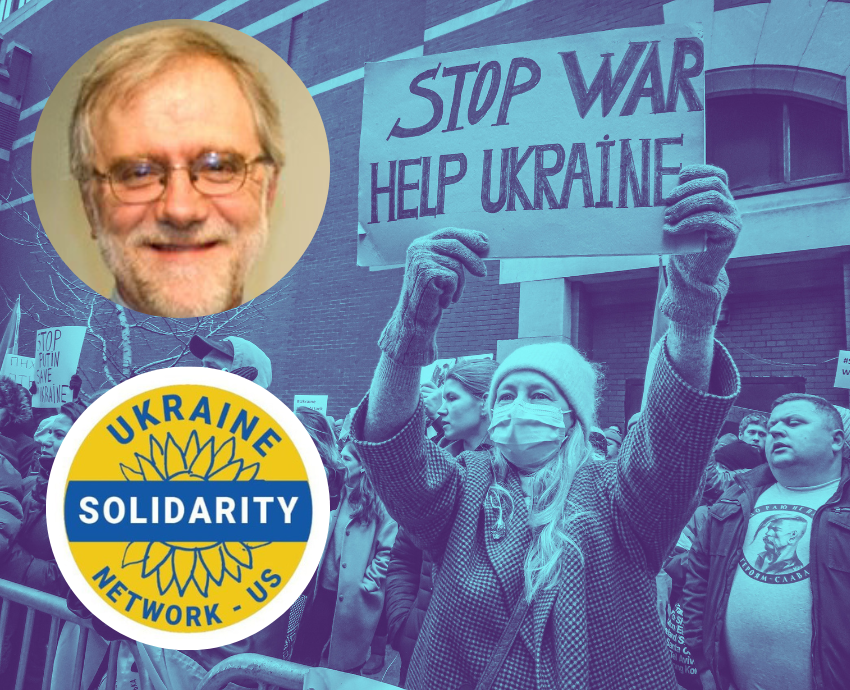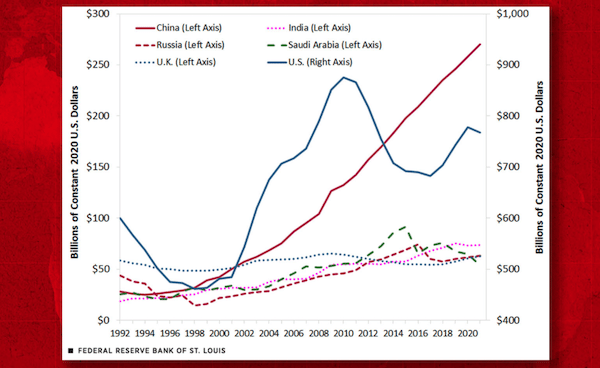
Nearly a year in, the war in Ukraine has cost hundreds of thousands of lives and brought the world to the brink of, in President Joe Biden’s own words, “Armageddon.” Alongside the literal battlefield, there has been a similarly bitter intellectual battle over the war’s causes.
This article is distributed by Globetrotter in partnership with the American Committee for U.S.-Russia Accord.
Commentators have rushed to declare the long-criticized policy of NATO expansion as irrelevant to the war’s outbreak, or as a mere fig leaf used by Russian President Vladimir Putin to mask what former Secretary of State Condoleezza Rice and former Defense Secretary Robert Gates recently called “his messianic mission” to “reestablish the Russian Empire,” in a Washington Post opinion piece. Fiona Hill, a presidential adviser to two Republican administrations, has deemed these views merely the product of a “Russian information war and psychological operation,” resulting in “masses of the U.S. public… blaming NATO, or blaming the U.S. for this outcome.”
Yet a review of the public record and dozens of diplomatic cables made publicly available via WikiLeaks show that U.S. officials were aware, or were directly told over the span of years that expanding NATO was viewed by Russian officials well beyond Putin as a major threat and provocation; that expanding it to Ukraine was a particularly bright red line for Moscow; that such action would inflame and empower hawkish, nationalist parts of the Russian political spectrum; and that it could ultimately lead to war.
In a particularly prophetic set of warnings, U.S. officials were told that pushing for Ukrainian membership in NATO would not only increase the chance of Russian meddling in the country but also risked destabilizing the divided nation—and that the United States and other NATO officials pressured Ukrainian leaders to reshape this unfriendly public opinion in response. All of this was told to U.S. officials in both public and private by not just senior Russian officials going all the way up to the presidency, but by NATO allies, various analysts and experts, liberal Russian voices critical of Putin, and even, sometimes, U.S. diplomats themselves.
This history is particularly relevant as U.S. officials now test the red line China has drawn around Taiwan’s independence, risking military escalation that will first and foremost be aimed at the island state. The U.S. diplomatic record regarding NATO expansion suggests the perils of ignoring or outright crossing another military power’s red lines and the wisdom of a more restrained foreign policy that treats other powers’ spheres of influence with the same care they extend to the United States.
An Early Exception
NATO expansion had been fraught from the start. The pro-Western, then-Russian President Boris Yeltsin had told then-U.S. President Bill Clinton he “[saw] nothing but humiliation for Russia if you proceed” with plans to renege on the verbal promises made years earlier not to extend NATO eastward, and warned that this move would be “sowing the seeds of mistrust” and would “be interpreted, and not only in Russia, as the beginning of a new split in Europe.” Just as containment architect George Kennan had predicted, the decision to go ahead with NATO expansion helped inflame Russian hostility and nationalism: The Duma (the Russian parliament) declared it “the largest military threat to our country over the last 50 years,” while the leader of the opposition Communist Party called it “a Treaty of Versailles for Russia.”
By the time Putin became president the day before the new millennium, “the initial hopes and plans of the early ’90s [were] dead,” a leading liberal Russian politician declared. The first round of NATO enlargement was followed by the organization bombing Yugoslavia in 1999, which was done without the UN Security Council authorization, and triggered Russia to cut off contact with the alliance. By 2000, the revised Russian national security strategy warned that NATO’s use of force beyond its borders would be seen as “a threat of destabilization of the whole strategic situation,” while military officers and politicians started claiming “that if NATO expands further, it would ‘create a base to intervene in Russia itself,’” the Washington Post reported.
Ironically, there would be one exception to the next two decades’ worth of rising tensions over NATO’s eastward expansion that followed: the early years of Putin’s presidency, when the new Russian president defied the Russian establishment to try and make outreach to the United States. Under Putin, Moscow reestablished relations with NATO, finally ratified the START II arms control treaty, and even publicly floated the idea of Russia eventually joining the alliance, inviting attacks from his political rivals for doing so. Even so, Putin continued to raise Moscow’s traditional concerns about the alliance’s expansion, telling NATO’s secretary-general it was “a threat to Russia” in February 2001.
“[I]f a country like Russia feels threatened, this would destabilize the situation in Europe and the entire world,” he said in a speech in Berlin in 2000.
Putin softened his opposition as he sought to make common cause with then-President George W. Bush administration. “If NATO takes on a different shape and is becoming a political organization, of course, we would reconsider our position with regard to such expansion, if we are to feel involved in the processes,” he said in October 2001, drawing attacks from political rivals and other Russian elites.
As NATO for the first time granted Russia a consultative role in its decision-making in 2002, Putin sought to assist its expansion. Then-Italian President Silvio Berlusconi made a “personal request” to Bush, according to an April 2002 cable, to “understand Putin’s domestic requirements,” that he “needs to be seen as part of the NATO family,” and to give him “help in building Russian public opinion to support NATO enlargement.” In another cable, a top-ranking U.S. State Department official urged holding a NATO-Russia summit to “help President Putin neutralize opposition to enlargement,” after the Russian leader said allowing NATO expansion without an agreement on a new NATO-Russia partnership would be politically impossible for him.
This would be the last time any Russian openness toward NATO expansion was recorded in the diplomatic record published by WikiLeaks.
Allies Weigh In
By the middle of the 2000s, U.S.-Russian relations had deteriorated, partly owing to Putin’s bristling at U.S. criticism of his growing authoritarianism at home, and to U.S. opposition to his meddling in the 2004 Ukrainian election. But as explained in a September 2007 cable by then-President of New Eurasia Foundation Andrey Kortunov, now director general of the Russian International Affairs Council—who has publicly criticized both Kremlin policy and the current war—United States mistakes were also to blame, including Bush’s invasion of Iraq and a general sense that he had given little in return for Putin’s concessions.
“Putin had clearly embarked on an ‘integrationist’ foreign policy at the beginning of his second presidential term, which was fueled by the 9/11 terrorist attacks and good relations with key leaders like President Bush” and other leading NATO allies, Kortunov said according to the cable. “However,” he said, “a string of perceived anti-Russian initiatives,” which included Bush’s withdrawal from the Anti-Ballistic Missile (ABM) Treaty and “further expansion of NATO,” ultimately “dashed Putin’s hopes.”
What followed was a steady drumbeat of warnings about NATO’s expansion, particularly regarding neighboring Ukraine and Georgia, much of it from Washington’s NATO allies.
“[Former French presidential diplomatic adviser Maurice] Gourdault-Montagne warned that the question of Ukrainian accession to NATO remained extremely sensitive for Moscow, and concluded that if there remained one potential cause for war in Europe, it was Ukraine,” reads a September 2005 cable. “He added that some in the Russian administration felt we were doing too much in their core zone of interest, and one could wonder whether the Russians might launch a move similar to Prague in 1968, to see what the West would do.”
This was just one of many similar warnings from French officials that admitting Ukraine and Georgia into NATO “would cross Russian ‘tripwires’,” for instance. A February 2007 cable records then-French Director General for Political Affairs Gérard Araud’s recounting of “a half-hour anti-U.S. harangue” by Putin in which he “linked all the dots” of Russian unhappiness with U.S. behavior, including “U.S. unilateralism, its denial of the reality of multipolarity, [and] the anti-Russian nature of NATO enlargement.”
Germany likewise raised repeated concerns about a potentially bad Russian reaction to a NATO Membership Action Plan (MAP) for Ukraine and Georgia, with then-Deputy National Security Adviser Rolf Nikel stressing that Ukraine’s entry was particularly sensitive. “While Georgia was ‘just a bug on the skin of the bear,’ Ukraine was inseparably identified with Russia, going back to Vladimir of [Kyiv] in 988,” Nikel recounted, according to the cable.
Other NATO allies repeated similar concerns. In a January 2008 cable, Italy affirmed it was a “strong advocate” for other states’ entry into the alliance, “but is concerned about provoking Russia through hurried Georgian integration.” Norway’s then-Foreign Minister (who is now the prime minister) Jonas Gahr Støre made a similar point in an April 2008 cable, even as he insisted Russia mustn’t be able to veto NATO’s decisions. “At the same time he says that he understands Russia’s objections to NATO enlargement and that the alliance needs to work to normalize the relationship with Russia,” reads the cable.
Almost Complete Consensus
The thinkers and analysts that U.S. officials conferred with likewise made clear that the anxieties of Russian elites over NATO and its expansion, and the lengths they might go to counteract it. Many were transmitted by then-U.S. Ambassador to Russia William Burns, who is presently Biden’s CIA director.
Recounting his conversations with various “Russian observers” from both regional and U.S. think tanks, Burns concluded in a March 2007 cable that “NATO enlargement and U.S. missile defense deployments in Europe play to the classic Russian fear of encirclement.” Ukraine and Georgia’s entry “represents an ‘unthinkable’ predicament for Russia,” he reported six months later, warning that Moscow would “cause enough trouble in Georgia” and counted on “continued political disarray in Ukraine” to halt it. In an especially prescient set of cables, he summed up scholars’ views that the emerging Russia-China relationship was largely “the by-product of ‘bad’ U.S. policies,” and was unsustainable—“unless continued NATO enlargement pushed Russia and China even closer together.”
Cables record Russian intellectuals across the political spectrum making such points again and again. One June 2007 cable records the words of a “liberal defense expert Aleksey Arbatov” and the “liberal editor” of a leading Russian foreign policy journal, Fyodor Lukyanov, that after Russia had done “everything to ‘help’ the U.S. post-9/11, including opening up Central Asia for coalition anti-terrorism efforts,” it had expected “respect for Russia’s ‘legitimate interests.’” Instead, Lukyanov said, it had been “confronted with NATO expansion, zero-sum competition in Georgia and Ukraine, and U.S. military installations in Russia’s backyard.”
“Ukraine was, in the long term, the most potentially destabilizing factor in U.S.-Russian relations, given the level of emotion and neuralgia triggered by its quest for NATO membership,” stated the counsel of Dmitri Trenin, then-deputy director of the Russian branch of the U.S.-based Carnegie Endowment for International Peace, in a Burns-authored February 2008 cable. For Ukraine, he said prophetically, it would mean “that elements within the Russian establishment would be encouraged to meddle, stimulating U.S. overt encouragement of opposing political forces, and leaving the United States and Russia in a classic confrontational posture.”
Indeed, opposing NATO’s enlargement eastward, particularly in Ukraine and Georgia, was “one of the few security areas where there is almost complete consensus among Russian policymakers, experts and the informed population,” stated a cable of March 2008, citing defense and security experts. Ukraine was the “line of last resort” that would complete Russia’s encirclement, said one defense expert, and its entry into NATO was universally viewed by the Russian political elite as an “unfriendly act.” Other experts cautioned “that Putin would be forced to respond to Russian nationalist feelings opposing membership” of Georgia, and that offering MAP to either Ukraine or Georgia would trigger a cut-back in the Russian military’s genuine desire for cooperation with NATO.
From Liberals to Hardliners
These analysts were reiterating what cables show U.S. officials heard again and again from Russian officials themselves, whether diplomats, members of parliament, or senior Russian officials all the way up to the presidency, recorded in nearly three-dozen cables at least.
NATO enlargement was “worrisome,” said one Duma member, while Russian generals were “suspicious of NATO and U.S. intentions,” cables record. Just as analysts and NATO officials had said, Kremlin officials characterized NATO’s designs on Georgia and Ukraine as especially objectionable, with the Russian Ambassador to NATO from 2008 to 2011, Dmitry Rogozin, stressing in a February 2008 cable that offering MAP to either “would negatively impact NATO’s relations with Russia” and “raise tension along the borders between NATO and Russia.”
Then-Russian Deputy Foreign Minister Grigory Karasin “underscored the depth of Russian opposition” to their membership, a different March 2008 cable stated, underlining that the “political elite firmly believes” “that the accession of Ukraine and Georgia represented a direct security threat to Russia.” The future, Karasin said, rested on the “strategic choice” Washington made about “‘what kind of Russia’” it wanted to deal with—‘a Russia that is stable and ready to calmly discuss issues with the U.S., Europe and China, or one that is deeply concerned and filled with nervousness.’”
Indeed, numerous officials—including then-Director for Security and Disarmament Anatoly Antonov, who is currently serving as Russia’s ambassador to the United States—warned pushing ahead would produce a less cooperative Russia. Pushing NATO’s borders to the two former Soviet states “threatened Russian and the entire region’s security, and could also negatively impact Russia’s willingness to cooperate in the [NATO-Russia Council],” one Russian foreign ministry official warned, while others pointed to the policy to explain Putin’s threats to suspend the Conventional Armed Forces in Europe (CFE) treaty. “CFE would not survive NATO enlargement,” went a Russian threat in one March 2008 cable.
Maybe most pertinent were the words of Russian Foreign Minister Sergey Lavrov, at the time a veteran diplomat respected in the West, and who continues to serve in the position today. At least eight cables—many, though not all of them, written by Burns—record Lavrov’s expressions of opposition to expanding NATO to Ukraine and Georgia over the course of 2007-2008, when Bush’s decision, over the objections of allies, to publicly affirm their future accession led to a spike in tensions.
“While Russia might believe statements from the West that NATO was not directed against Russia, when one looked at recent military activities in NATO countries… they had to be evaluated not by stated intentions but by potential,” went Burns’s summary of Lavrov’s annual foreign policy review in January 2008. On the same day, he wrote, a foreign ministry spokesperson warned that Ukraine’s “likely integration into NATO would seriously complicate the many-sided Russian-Ukrainian relations” and lead Moscow to “have to take appropriate measures.”
Besides being an easy way to garner domestic support from nationalists, Burns wrote, “Russia’s opposition to NATO membership for Ukraine and Georgia is both emotional and based on perceived strategic concerns about the impact on Russia’s interests in the region.”
“While Russian opposition to the first round of NATO enlargement in the mid-1990s was strong, Russia now feels itself able to respond more forcefully to what it perceives as actions contrary to its national interests,” he concluded.
Lavrov’s criticism was shared by a host of other officials, not all of them hardliners. Burns recounted a meeting with former Prime Minister Yevgeny Primakov, a Gorbachev protégé who had negotiated over NATO’s first expansion with former Secretary of State Madeleine Albright, who warmly eulogized him years later as a pragmatist. The U.S. push for MAP for Georgia and Ukraine “‘infuriated’ Russians and threatened other areas of U.S.-Russia strategic cooperation,” Primakov had said, according to Burns, mentioning Primakov was asked later that day on TV about rethinking Crimea’s status as Ukrainian territory. “[T]his is the kind of discussion that MAP produces,” he said—meaning that it inflamed nationalist and hardline sentiment.
“Primakov said that Russia would never return to the era of the early 1990s and it would be a ‘colossal mistake’ to think that Russian reactions today would mirror those during its time of strategic weakness,” Burns’s cable stated.
This went all the way to the top, as U.S. officials noted in cables reacting to a famously strident speech Putin gave at the Munich Security Conference in February 2007, which saw Putin assail NATO expansion and other policies as part of a wider, destabilizing U.S. abuse of its sole-superpower status. Putin’s tone may have been “unusually sharp,” Primakov told Burns, but its substance “reflected well-known Russian complaints predating Putin’s election,” shown by the fact that “talking heads and Duma members were almost unanimous” in supporting the speech. A year later, a March 2008 cable reported then-German Chancellor Angela Merkel’s farewell, two-hour-long meeting with Putin, in which he “argued strongly” against MAP for Ukraine and Georgia.
Putin’s Exit
Any illusions this stance would evaporate with Putin leaving the presidency were quickly dispelled. Such warnings continued and, if anything, grew more intense after Putin was replaced by his liberal successor, Dmitry Medvedev as president of Russia, whose ascent sparked hopes for a more democratic Russia and an improved U.S.-Russian relationship.
Under Medvedev, officials from the Russian ambassador to NATO and various officials in the foreign ministry to the chairman of the Duma’s international affairs committee made much the same warnings, cables show. In some cases, as with Karasin and Lavrov, it was the same officials making these long-standing complaints.
Medvedev himself “reiterated well-known Russian positions on NATO enlargement” to Merkel on his first trip to Europe in June 2008, even as he avoided bringing up MAP for Ukraine and Georgia specifically. “Behind Medvedev’s polite demeanor, Russian opposition to NATO enlargement remained a red-line, according to both conservative and moderate observers,” one June 2008 cable reads, a view shared by a leading liberal analyst. Even critics to his right read Medvedev’s words as “an implicit commitment to use Russian economic, political and social levers to raise the costs for Ukraine and Georgia” if they moved closer to the alliance. The cable’s author, then-Deputy Chief of Mission at the U.S. Embassy in Moscow Daniel Russell, concluded he “agree[d] with the common wisdom.”
By August 2008, following the war with Georgia, Medvedev started to sound a lot more like his predecessor, threatening to cut ties with the alliance and restating grievances about encirclement. A cable from after the end of the five-day war between Russia and Georgia—which an EU-commissioned report would later blame the Georgian government for starting—stated that “even the most pro-Western political experts” were “pointing the finger at the U.S.” for jeopardizing the U.S.-Russian relations, with U.S.’s dismissal of Russia’s concerns over, among other things, NATO expansion being a key part of their analysis. Echoing Burns, one analyst argued that Russia finally felt “strong enough to stand up to the West” when it ignored its concerns.
Those concerns were central at a roundtable of Russian analysts months later— a January 2009 cable showed—who explained to a group of visiting U.S. congresspeople Russians’ “deep displeasure” with the U.S. government, and stressed the “bitter divorce” between Russia and Georgia would be even uglier with Ukraine. Pushing MAP for the country “helped the ‘America haters come to power’ in Russia and gave legitimacy to the hard-liners’ vision of ‘fortress Russia,’” said one Russian analyst.
Increasingly, cables show, such warnings came from liberals, even those who hadn’t previously viewed NATO and the United States as Russia’s chief threats. An August 2008 cable described a meeting with Russian Human Rights Ombudsman Ambassador Vladimir Lukin—described as “a liberal on the Russian political scene, someone disposed toward cooperation with the U.S.”—who explained Medvedev’s post-war recognition of the independence of Georgia’s breakaway regions, which he had at first opposed, as a security-driven response to NATO’s drift toward Russia’s borders. Because escalations like the 2008 U.S.-Poland missile defense agreement showed anti-Russia actions “would not stop,” he said, “Moscow had to show that, like the U.S., it can and will take steps it deems necessary to defend its interests.”
The cable concluded that Lukin’s views “reflect the thinking of the majority of Russian foreign policy elite.”
Selling NATO to Ukraine
Other than Burns—whose Bush-era memos warning of the breadth of Russian opposition to NATO expansion and that it would provoke intensified meddling in Ukraine have become famous since the Russian invasion—U.S. officials largely reacted with dismissal.
Russian objections to the policy and other long-simmering issues were described over and over in the cables as “oft-heard,” “old,” “nothing new,” and “largely predictable,” a “familiar litany” and a “rehashing” that “provided little new substance.” Even NATO’s ally Norway’s position that it understood Russian objections even as it refused to let Moscow veto the alliance’s moves was labeled a case of “parroting Russia’s line.”
U.S. officials were similarly dismissive of explicit warnings—from Kremlin officials, NATO allies, experts and analysts, even Ukrainian leadership—that Ukraine was “internally divided over NATO membership” and that public support for the move was “not fully ripe.” The east-west split within Ukraine over the idea of NATO membership made it “risky,” German officials cautioned, and could “break up the country.” Ukraine’s three leading politicians all “took foreign policy positions based on domestic political considerations, with little regard to the long-term effects on the country,” one said.
Those very politicians likewise made clear public opinion wasn’t there, whether anti-Russian former Foreign Minister Volodymyr Ogryzko of Ukraine, or more Russian-friendly former Prime Minister Viktor Yanukovych—later misleadingly painted as a Kremlin puppet and was ousted as president in the 2014 Maidan protests—who boasted to a U.S. diplomat that support for NATO had jumped under his tenure. In response, the cables show, NATO officials pressed Ukrainian leaders to take a firm public stance in favor of joining, and discussed how to persuade Ukraine’s population “so that they would be more favorable [toward] it.” Ogryzko later disclosed to Merkel “that a public education campaign is already underway,” and that Ukraine “had discussed the issue of public education campaigns with Slovakia and other nations that had joined NATO recently.”
This came in spite of acknowledged risks. Cables record liberal Russian analysts cautioning “that [then-Ukrainian President Viktor] Yushchenko was using NATO membership to shore up a Ukrainian national identity that required casting Russia in the role of enemy,” and that “because membership remained divisive in Ukrainian domestic politics, it created an opening for Russian intervention.”
“Experts tell us that Russia is particularly worried that the strong divisions in Ukraine over NATO membership, with much of the ethnic-Russian community against membership, could lead to a major split, involving violence or at worst, civil war,” Burns wrote in February 2008. Russia, he further wrote, would then “have to decide whether to intervene; a decision Russia does not want to have to face.”
Despite the dismissive attitude of many U.S. officials, parts of the U.S. national security establishment clearly understood Russian objections weren’t mere “muscle-flexing.” The Kremlin’s anxieties over a “direct military attack on Russia” were “very real,” and could drive its leaders to make rash, self-defeating decisions, stated a 2019 report from the Pentagon-funded RAND Corporation that explored theoretical strategies for overextending Russia.
“Providing more U.S. military equipment and advice” to Ukraine, it stated, could lead Moscow to “respond by mounting a new offensive and seizing more Ukrainian territory”—something not necessarily good for U.S. interests, let alone Ukraine’s, it noted.
Warnings Ignored
Nevertheless, in the years, months, and weeks that led up to the Russian invasion of Ukraine in February 2022, successive U.S. administrations continued on the same course.
Ukraine’s cooperation with NATO has “deepened over time,” the alliance itself says today. By the war’s outbreak, the country frequently hosted Western troops at a military base, Ukrainian soldiers received NATO training, it planned two new NATO-linked naval bases, and has received unprecedented sums of U.S. military aid, including offensive arms—a former President Donald Trump policy his liberal predecessor had explicitly rejected, out of concern for provoking a disastrous response from Moscow. Three months before the invasion, Ukraine and the United States signed an updated Charter on Strategic Partnership “guided” by Bush’s controversial Bucharest declaration, which both deepened security cooperation between the two countries and supported Ukraine’s membership aspirations, viewed as an escalation in Moscow.
As U.S. military activity has increased in the region since 2016, sometimes involving Ukraine and Georgia, NATO-Russian tensions have ratcheted up too. While Moscow publicly objected to U.S. missions in Europe that experts feared were too provocative, NATO and Russian forces have experienced thousands of dangerous military encounters in the region and elsewhere. By December 2022, with fears of invasion ramping up, Putin told Biden personally that “the eastward expansion of the Western alliance was a major factor in his decision to send troops to Ukraine’s border,” the Washington Post reported.
None of this means other factors played no role in the war’s outbreak, from Russian domestic pressures and Putin’s own dim view of Ukrainian independence to the copious other well-known Russian grievances toward U.S. policy that frequently appear in the diplomatic record, too. Nor does it mean, as hawks argue, that this somehow “justifies” Putin’s war, any more than understanding how U.S. foreign policy has fueled anti-American terrorism that “justifies” those crimes.
What it does mean is that claims that Russian unhappiness over NATO expansion is irrelevant, a mere “fig leaf” for pure expansionism, or simply Kremlin propaganda are belied by this lengthy historical record. Rather, successive U.S. administrations pushed ahead with the policy despite being warned copiously for years—including by the analysts who advised them, by allies, even by their own officials—that it would feed Russian nationalism, create a more hostile Moscow, foster instability and even civil war in Ukraine, and could eventually lead to Russian military intervention, all of which ended up happening.
“I don’t accept anyone’s red line,” Biden said in the lead-up to the invasion, as his administration rejected negotiations with Moscow over Ukraine’s NATO status. We can only imagine the world in which he and his predecessors had.
Author Bio: Branko Marcetic is a Jacobin staff writer and the author of Yesterday’s Man: The Case Against Joe Biden.




 Anastasia Witts speaking at a protest in the U.K. (WNV/Anastasia Witts)
Anastasia Witts speaking at a protest in the U.K. (WNV/Anastasia Witts)  Alexey Minyaylo
Alexey Minyaylo 
 Vera Horton at a Belarusian diaspora women’s protest in London last year. (WNV/Vera Horton)
Vera Horton at a Belarusian diaspora women’s protest in London last year. (WNV/Vera Horton) 
 Vladislava Petrova at one of the first Russian protests in front of Russian Embassy in London last April. (WNV/Vladislava Petrova)
Vladislava Petrova at one of the first Russian protests in front of Russian Embassy in London last April. (WNV/Vladislava Petrova)  Vera Horton marching against the war in London last year. (WNV/Vera Horton)
Vera Horton marching against the war in London last year. (WNV/Vera Horton)  An ethnic Sakha protests the war in Ukraine in London. (Indigenous in London/Anita Berkhané)
An ethnic Sakha protests the war in Ukraine in London. (Indigenous in London/Anita Berkhané) 


